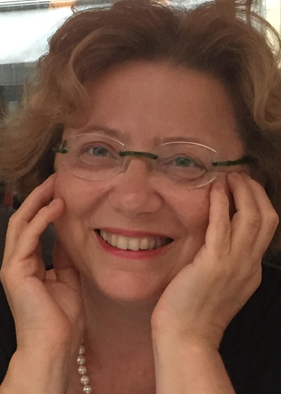November 2022, Year XIV, no. 11
Elisa Molinari
The Imaginative Physicist
“Imagining and then watching a lab grow that is full of young people, male and female researchers from different backgrounds, disciplines and countries, where universities and research institutions really combine their strengths to deal with even the most ambitious scientific problems: this is the real challenge in Italy. But it’s worth it.”
Telos: Nanoscience and nanotechnology. What are they? How are they present in our everyday life? In our “biology”?
Elisa Molinari: They regard the behavior of matter -all matter- on a scale of one millionth of a millimeter, or nanometers. This is the same scale found in the best chips in our mobile phones and computers, and of the DNA cross-sectional dimension or small proteins.
This scale is special because it is at this scale that electrons, atoms, molecules and surfaces interact and determine the macroscopic properties of materials, from color to electrical and thermal properties. It is here that unexpected phenomena occur, triggering processes that control both artificial devices and biological functions: from “beneficial” functions like photosynthesis to the emergence of undesirable phenomena like neurodegenerative disorders.
The aim of our research is to understand these processes using quantum physics –which is essential on that scale– to design new materials and phenomena and come up with new technologies. Now we are focusing on phenomena that are important for (opto)electronic chips as well as for solar panels and the batteries of the future.
To do this we need to develop both the theory and calculation codes to simulate materials using computers (i.e.in silico) in order to direct and interpret experiments and automated design, which speeds innovation and application enormously.
Where is Italy positioned in all of this? Leonardo is the fourth most powerful supercomputer in the world and has just been inaugurated at the Tecnopolo in Bologna. Could you share a bit about this success story for our Country?
Italy had an excellent position in Europe and in the world, and Leonardo is another important step indeed. We aren’t just talking about the classification of supercomputers. In the past Cineca (TN: the largest Italian computing centre) has ranked highly in the TOP500 and the Green500 while other Italian industrial entities have high-performing supercomputing capacity, especially Italian energy multinational Eni SpA and now, for example, Italian aerospace, defense and security giant Leonardo SpA.
One important thing that is happening with the new Leonardo supercomputer is that it is a joint European effort, also coordinated by EuroHPC Joint Undertaking, to create a high-performance supercomputing and data ecosystem at the European level, so Europe can be more independent in the future, also in terms of the development and production of the related technologies.
This is an extremely ambitious long-term goal, because today there is a huge gap between the use and design/production of digital technologies in Europe. However, it is crucial that control over these technologies not be given up on all levels.
Here, Italy can play a key role in research, starting with the one on materials design and the nanoelectronics of the future. So the new supercomputer Leonardo is exactly what we need to simulate and design processors as well as… future Leonardos, which we want to be more efficient and sustainable all around.
Regarding the ecosystem and Italy’s role, I’d like to stress a little-known but increasingly important, globally acknowledged point of excellence: our ability to generate codes and workflows for what we call “big irons”, i.e. the hardware, and also to produce and analyse large volumes of data for complete applications. Knowing how to produce codes, and not just use those written by others, is an essential lever to drive the science and technology of the future. The strategy of making them available to all in open-source is proving to be right and forward-looking.
Today the most important and widespread materials simulation codes are being developed in Europe. Italy is the main player in the development of open-source codes based on quantum mechanics. Starting with the SISSA, the International School for Advanced Studies in Trieste as well as the CNR, the National Research Council, and the Universities of Modena, Rome, Udine, and so on, and today at the National Centre launched by the National Recovery and Resilience Plan the most widespread codes in the world are being created along with the skills so that supercomputers can be effectively used for scientific and industrial applications.
In fact, we are the ones coordinating the MaX, the European Centre of Excellence in materials supercomputing. Today even policy-makers have started realising that codes, algorithms and skills are key future resources, not an accidental byproduct of the research on applications.
Many global hardware producers have figured this out. This is why they want to collaborate with us and use our codes as computer benchmarks. Many directors of research centers and institutes throughout the world, including some of the leading directors of Italian supercomputing centers, even in industry, began by doing computing research on materials in Italy (many are even from Modena).
We can leverage these successes and skills in order to play a key role in Europe. These skills are built over the long term and we have proven we can do it. Today training and having people with these skills are essential to the future of the production and service industry, in addition to science and technology. This is what we always hear from companies, which is why continuing to invest in code and on training is worth it, especially over the long term.
Women and STEM, two words that were not ordinarily used together in the past. Today what policies do we need to close the gender gap in STEM disciplines?
Many of the policies are the same ones we need to attract and keep interesting prospects from each sex! I mean, policies aimed at creating a stimulating and inclusive work environment that is compatible with people’s diverse interests and life choices, where the goals are ambitious and the work prospects are clear and long-term.
Women are not afraid of challenge or responsibility if they aren’t penalised by the rules of the game. You have to work hard to identify and root out hidden penalties and create concrete support tools and specific calls for applications. The opportunities are out there, and some have even been inspired by success stories from other countries. I hope women will be willing.
This isn’t just about democracy, because the possibility and responsibility of learning about these technologies and influencing the choices that affect our future are open to everyone. It is also about broadening the pool of young people who can contribute to building the future by appreciating different visions and ways of doing things. So it is worth investing in this with determination.This means we have to prepare ourselves to deeply change our method of assessment and research to bring them closer to international standards and appreciate everybody’s contribution. And institutions, departments and companies need to be rewarded consistently when they show that they have made a concrete effort and obtained results to contrast the gender gap, both at the beginning of women’s careers and once their careers are underway. Otherwise, it will take 100 years to close the gap!
Then we need to invest in work with schools and teachers, and in coordinated initiatives with universities and research institutes. This is the only way we can build projects that girls find exciting and mobilise the best forces to carry them out. The paradox is that these initiatives often come at almost no cost and receive almost no support or recognition, and require a huge effort by the people involved.
You have a very long career as a scientist and an extraordinary résumé, to say the least. You were chosen by the Italian Ministry for Universities and Research as one of the eight experts for the National Recovery and Resilience Plan and by many international centres for their scientific boards. Which of your many experiences was the most challenging?
Maybe I’d say one of my prestigious experiences in the large international research institutes. But actually I enjoy building new initiatives that involve people and leave a mark, from the S3 Research Centre of the National Institute of Materials Physics INFM, which I founded and led for a long time in Modena (now part of the National Research Council), to the MaX Center, which I am currently the coordinator of. Imagining and then watching a lab grow that is full of young people, male and female researchers from different backgrounds, disciplines and countries, where universities and research institutions really combine their strengths to deal with even the most ambitious scientific problems: this is the real challenge in Italy. But it’s worth it.
Marco Sonsini
Editorial
2022 is the year of science for PRIMOPIANOSCALAc. No, it’s the year of physics. After our interview with Italian Nobel Prize winner Giorgio Parisi, it is an honour to have as our guest for the November issue the brilliant, bold, imaginative Prof. Elisa Molinari, who is capable of changing the world with her research. Right off the bat, we asked Molinari to tell us about her area of research: nanotechnology. She explains it clearly and simply. Not only does she tell us what it is about, she tells us what it is for.“The aim of our research is to understand these processes using quantum physics, which is essential on that scale to design new materials and phenomena and come up with new technologies.” The word imagine seems strange coming from the mouth of a scientist, who most people may think always get stuck searching for and, at most, trying to understand and classify phenomena. Not so. Molinari and the scientists in the labs she directs actually design phenomena. The word imagine is reoccurring throughout her interview.
When we ask her about the greatest challenge she has had to face, Molinari sets aside her international experience and answers “Imagining and then watching a lab grow that is full of young people, male and female researchers…”
Each of the Prof’s answers is permeated with positivity and optimism. Yes, Leonardo will project Italy into supercomputing. However, this is just one step on a path of excellence in this field that has been going on for years.
She tells us the area where we are really making a difference is in “our ability to generate codes and workflows for what we call “big irons”, i.e. the hardware for complete applications.” This ability is what allows us to create new materials. Industry has figured this out and “wants to collaborate with us and use our codes as computer benchmarks.”
Finally, just one comment on the relationship between women and science. The female historical figures who really stand out in history come mainly from the humanities, painters, writers, poets, rarely scientists. In fact, the sciences, and in particular the so-called hard sciences such as physics, require not only a solid basic training, but also facilities and laboratories.
So after getting excluded from the universities, excluded from scientific education, women stood out wherever they were able to. This gave rise to a sort of prejudice that assumed that women were more suited to literature and languages than to scientific disciplines. Today, things have changed and women are more aware. They know how to form support networks and make their way in a world they did not have access to for a long time. But it still isn’t enough.
Molinari believes that women and girls are a wellspring of ability. The greater involvement of women in science would help to satisfy the needs of the industry. In public debate, Molinari always reiterates the benefits of diversity. Women have abilities, attitudes and skills that are different from men’s, and a work environment with an equal representation of men and women would work better in her opinion.The interactive dynamics of women are different and they give more attention to alternatives to the main path, “We work on the same equations with the same scientific method but we often see different research paths, and this benefits the group as a whole. It is not surprising that investment is starting to be made in gendered innovation.”
She doesn’t fall into the easy trap of the victim mentality, and when we ask her what policies are needed to close the gender gap in science, she exclaims, “Many of the policies are the same ones we need to attract and keep interesting prospects from each sex!”
The November issue cover of PRIMOPIANOSCALAc sports the same graphic design as our other 2022 issues, with the same pop, oneiric look featuring the face of our guest and a collage of juxtaposed, unelaborated images that are symbols of her work, role and life arranged around her head like a hat.
For Molinari we have chosen symbols of Modena like the Lanfranco Cathedral and tortellini as well as cooking utensils, books, a suitcase, mountains and skiing to represent her passions. However, we give a lot of space to science, her life.
Amid the atoms, a laptop and calculators, there is also Marie Curie, a woman and scientist who seems to say to all girls who are passionate about the hard sciences: “Look for your allies wherever you happen to be. People who aren’t prejudiced against gender, age or ethnicity and who only see your ability. Look for them and may science be with you.”
Mariella Palazzolo

Elisa Molinari is Full Professor of Condensed Matter Physics at the Department of Physical, Computer and Mathematical Sciences at the University of Modena in Reggio Emilia, and is a member of the Nanosciences Institute of the CNR. Here she leads the European Centre of Excellence on Materials design at the eXascale (MaX), for materials simulation, discovery and design using high-performance computing and data analysis technologies.
Molinari has a Degree in Physics and from 1983 to 1985 she was a researcher at the Max-Planck-Institut für Festkörperforschung in Stuttgart and Grenoble. Then she returned to Italy where from 1985 to 1992 she was a researcher at the National Research Council in Rome.
In 1992 she began her career in academics at the University of Modena, first as an Associate Professor, then as a Full Professor starting in 2001.
From 2001 to 2018, she founded and directed the S3 Centre of the National Institute for the Physics of Matter (INFM) in Modena, later merged into the Nanoscience Institute of the CNR. Between 2007 and 2010 she led the INFM-CNR, comprising 21 research centres throughout Italy.
She is a Fellow of the American Physical Society (APS). She has coordinated important research projects at national and international level, and participated in major EU scientific and evaluation committees in the field of materials, nanotechnology and scientific computing.
She is one of the passionate founders of the Italian Association of Women in Science and from 2002-2003 she was Associate Secretary General of the International Union of Pure and Applied Physics (IUPAP), establishing the first Working Group for Women in Physics. Last June she was appointed to the Supervisory Board of the National Recovery and Resilience Plan at the Ministry for Universities and Research.
She loves to read and travel. She also adores the mountains and skiing whenever she gets the chance. She likes to cook "for all the party".
She was born in Modena, the city where she grew up and where she still lives today.
Marco Sonsini







SocialTelos